The AMD Radeon RX 5600 XT Review, Feat. Sapphire Pulse: A New Challenger For Mainstream Gaming
by Ryan Smith on January 21, 2020 9:01 AM ESTPower, Temperatures, & Noise
Last, but not least of course, is our look at power, temperatures, and noise levels. While a high performing card is good in its own right, an excellent card can deliver great performance while also keeping power consumption and the resulting noise levels in check.
| Radeon Video Card Voltages | |||||
| 5600 XT Max | 5700 Max | 5600 XT Idle | 5700 Idle | ||
| 0.977v | 1.025v | 0.775v | 0.775v | ||
Interestingly, even with the BIOS update and AMD’s voltage-frequency curve extension, the voltages being used by our Sapphire Radeon RX 5600 XT are quite tame. The card never goes higher than 0.977v, which is almost 0.05v lower than the Radeon RX 5700, itself already a good deal lower than the full-fat Navi 10-based Radeon RX 5700 XT. While third-tier cards like the RX 5600 XT are uncommon, when we do see them they are normally running higher voltage (leakier) parts, and this is what I was expecting for AMD’s new part.
No wonder AMD is talking up the power efficiency of the card; even with its restricted clockspeeds, not going above 1.0v helps to ensure that power efficiency doesn’t take a dive by paying a massive power penalty to access the last few MHz worth of headroom.
| Radeon Video Card Average Clockspeeds (Rounded to the Nearest 10MHz) |
||||
| Game | Sapphire 5600 XT (Perf) | 5600 XT | 5700 | |
| Max Boost Clock | 1760MHz | 1670MHz | 1750MHz | |
| Official Game Clock | 1615MHz | 1375MHz | 1625MHz | |
| Tomb Raider | 1700MHz | 1610MHz | 1680MHz | |
| F1 2019 | 1700MHz | 1610MHz | 1650MHz | |
| Assassin's Creed | 1700MHz | 1660MHz | 1700MHz | |
| Metro Exodus | 1700MHz | 1600MHz | 1640MHz | |
| Strange Brigade | 1740MHz | 1660MHz | 1660MHz | |
| Total War: TK | 1740MHz | 1660MHz | 1690MHz | |
| The Division 2 | 1700MHz | 1610MHz | 1630MHz | |
| Grand Theft Auto V | 1720MHz | 1640MHz | 1690MHz | |
| Forza Horizon 4 | 1730MHz | 1650MHz | 1700MHz | |
Shifting over to clockspeeds, things look very good for the RX 5600 XT. The card’s clockspeeds are remarkably consistent, and this comes down to the fact that the card is rarely ever entirely power-bound. Rather, the card is running out of room on the voltage-frequency curve, making it very easy to get close to its peak clockspeeds in the process. This goes hand-in-hand with the relatively low voltage, allowing the card to run rather efficiently and avoid heavier power throttling.
Unsurprisingly, the card is closer to its peak when running at AMD’s reference clockspeeds than it is the default factory overclocked mode. Still, the latter sees the card average clockspeeds higher than the RX 5700, underscoring how these factory overclocked cards are primed to hit high clockspeeds, and that it’s going to be the lack of memory bandwidth that ultimately keeps them chasing the RX 5700.

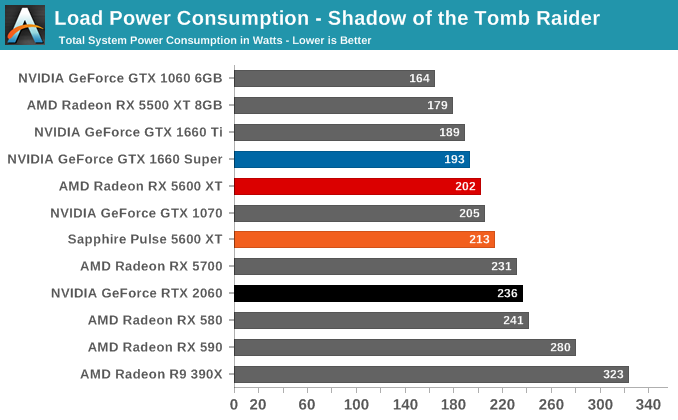
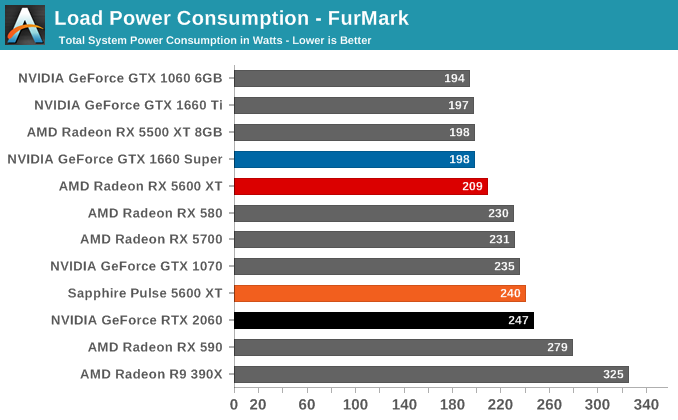
Taking a look at power consumption, we again find a good showing from Sapphire and AMD. The card’s idle power consumption shaves off a couple of watts at the wall relative to the RX 5700, thanks to the lower amount of VRAM and fully idled fans.
Meanwhile load power consumption also fares comparatively well. At reference clocks, we see AMD’s claims of higher power efficiency first-hand; measured at the wall, the card draws around 30W less than the RX 5700. Equally important, this keeps it relatively close to the GeForce GTX 1660 series. And while the RX 5600 XT ultimately ends up drawing more power, as we’ve seen it also handily outperforms those cards.
Sapphire factory overclock, however, is both a curse and a blessing. The blessing is that it improves the card’s performance to RTX 2060-levels, but the curse is that it does so while pushing power consumption to near RX 5700-levels. So when running at full tilt, the Pulse RX 5600 XT is less power efficient than the RX 5700, owing to its overall lower performance. Then again, it’s not like NVIDIA was doing very well to begin with. As a result, even when factory overclocked, the Pulse ends up drawing a bit less power than the nearest NVIDIA card.
I will also quickly note that the delta in power consumption between FurMark and Tomb Raider is higher for the RX 5600 XT than we’ve seen it in other Navi cards. All told, even at 1440p with the highest available settings, Tomb Raider is having a hard time keeping the RX 5600 XT busy enough that the card is running at maximum clockspeeds. This has made Tomb Raider turn into something of a best case scenario, as the card gets to idle a little bit.
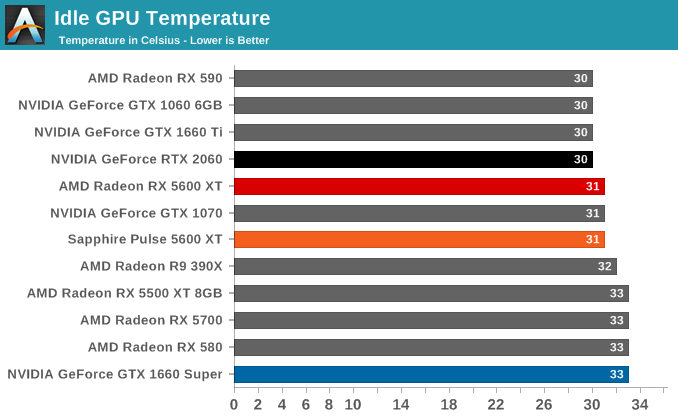
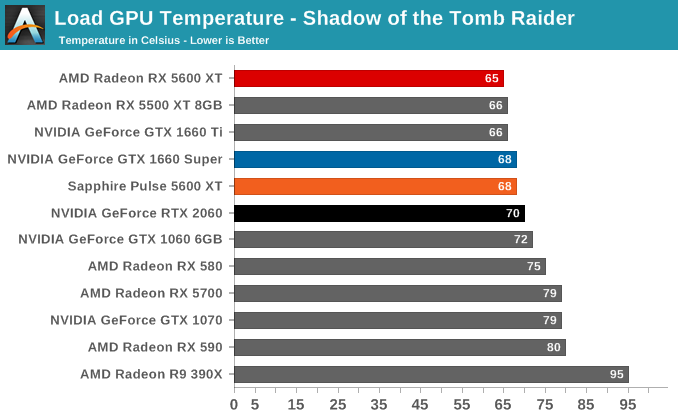

Moving on to temperatures, the large card has no problem cooling itself. In quiet mode the card never passes 68C, and even in full-on performance mode, the temperature maxes out at 74C. From a temperature perspective, Sapphire seems to have just about perfectly tuned the card’s cooler.
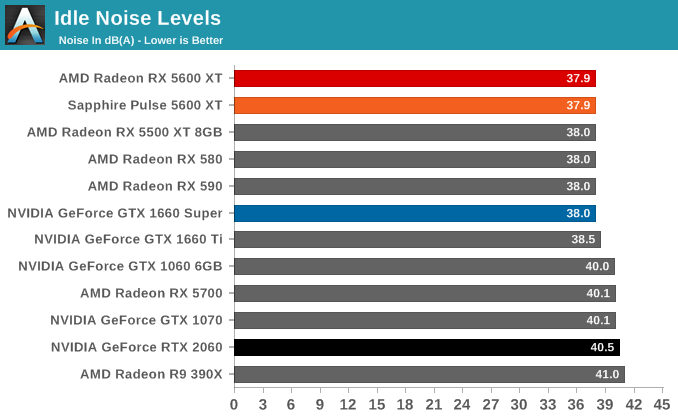
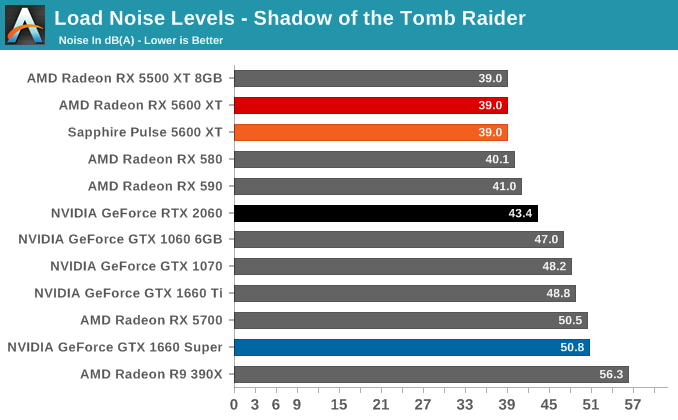

Finally, with noise, we get a chance to see how quietly the oversized Pulse can operate. And the answer is “very quietly”. At idle the card is entirely silent, thanks to its zero fan speed idle mode. Meanwhile with the quiet mode BIOS clocked at AMD’s reference clockspeeds, the fans only have to go to the card’s bare minimum fan speed – 25 percent – to keep the card cool, even under FurMark. To put this in context, we’re looking at a 150W card that’s having all of its cooling needs being met by a pair of fans running at a mere 750 RPM, which is a fraction of what they can actually run at.
Even with the factory overclock active, the cooler has no problem keeping up. Load noise for the 180W mode peaks at 41.2dB(A), which is close to silent and a great result overall. So for as much ribbing as I give Sapphire for the somewhat absurd size of the card, there’s no arguing with the effectiveness of the cooler. It’s quieter than almost every other card in this chart, including the GeForce GTX 1660 series cards and NVIDIA’s own reference RTX 2060.










202 Comments
View All Comments
Qasar - Thursday, January 23, 2020 - link
" nvidia drivers are near flawless " ha !!!!!!!!!!!! that's a good one. bias much cmdmonkey ??? as Korguz mentioned, you must have been very lucky, as for me, with both radeon and geforce, i have had issues with both over the years, but, that doesnt change my view on either, i buy what i can afford that gives the performance i am willing to pay for, and so far, that looks to be amd, and thats partly because i am sick of nvidia charging WAY to much for a video card, they must like pricing their cards so only the rich, or those with no families and mortgages, can buy them. i hope amd can do the same with the video cards, as they have with Zen. would be nice to see nvidia have to drop their prices by 800 or more like intel has had to do.Spunjji - Thursday, January 23, 2020 - link
Nvidia drivers have - in admittedly rare cases - actually destroyed cards. In more regular cases, they have bugs with setting resolutions, bugs with installation, and just the general sort of issues you'd expect from a large driver for complex hardware. They're no more immune from that than anyone else.This "AMD drives are baaaaad" trope will probably never die, but it'll never really be true either.
cmdrmonkey - Thursday, January 23, 2020 - link
For the record I'd actually love to see AMD produce good video cards again. Everything they've made in recent years has been trash. They make loud, hot, power guzzling, underperforming cards with bad drivers that rarely get updated. That's why they are down to 11% market share. Their cards suck.Qasar - Thursday, January 23, 2020 - link
oh look, an opinion from some that that looks like they hare heavily bias against amd for what ever reason. while their video cards in recent years hasnt been that good, but to be fair, there HAS been years, where nvidias were just as bad, same with their drivers. i guess he LOVES paying WAY to much for nvidia's products and wants to keep overpaying... is it safe to assume you also like over paying for intels current products too ?? nvidia is getting lazy, just like intel, and who knows, maybe they will follow in intels footsteps too.....cmdrmonkey - Thursday, January 23, 2020 - link
I actually hate overpaying and I hate nVidia having a monopoly. I want AMD to pull their heads out of their butts and stop producing video cards that are trash.Qasar - Thursday, January 23, 2020 - link
amds cards aren't trash, they are still pretty good for the price, and with nvidia charging way to much for theirs, amds cards are still quite usable, and at least most of them are affordable.cmdrmonkey - Thursday, January 23, 2020 - link
AMD cards are poo. And they aren't cheap enough that anyone would pick them over nVidia equivalents that run cooler and quieter and have better drivers.Qasar - Thursday, January 23, 2020 - link
your opinions are poo, and is just your personal OPINION, thats all.. there is nothing wrong with amds cards, just like there is nothing wrong with nvidias, some have issues with one, and not the other, and vice versa, as i said, i have issues with both. still better then paying the ridiculous prices that nvidia charges, as i also mentioned.. nvidia is getting lazy, been at the top too long, and it will bite them in the ass, maybe with the next release of RDNA2, or heck.. maybe it will come out of left field with intel and the Xe cards who knows.. IMO, your bias against amd shows.... and i hope you keep buying nivida and paying for those over priced cards....flyingpants265 - Thursday, January 23, 2020 - link
Hahaha, this post is embarrassing, you should stop posting on Anandtech.335 GT - Friday, January 31, 2020 - link
Why did the 5700xt win videocard of the year on the every site I saw? Shoo troll.